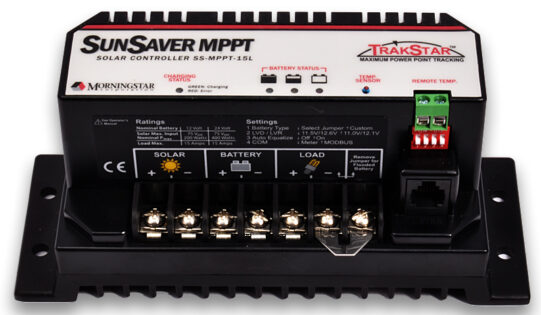So to answer the question ” what is a solar panel charge controller” ? Simply put, this is probably the most important piece of kit in a solar panel charging system for your motorhome or campervan. It is also probably the least understood part. Basically the charge controller is the heart & brains of the solar charging system. It maintains critical charging control and system monitoring.of the system.
Choosing the right Charge Controller really depends on:
- your power usage.
- your main touring locations.
- your time spent on electric hook up on site or wild camping.
- do you use an Inverter & appliances
So before you decide on which solar panel kit you need for your Motorhome or Campervan keep on reading the article.
What Does A Charge Controller Do ?
A solar charge controller is basically a voltage or current controller to charge the batteries to a full state of charge and keep them at that level without overcharging.
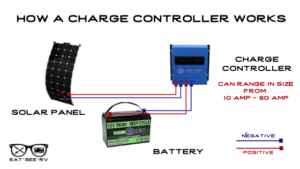
It directs & monitors the voltage and current that is generated by the solar panels to the battery. Generally, 12V solar panels put out in the region of 16 to 20V, so if there is no regulation the 12v electric cells within the battery will be seriously damaged from overcharging.
Overcharging of all types of batteries can cause irreparable damage & in lead-acid batteries it can cause excessive gassing that will actually “boil” the water away, damaging a battery’s plates by exposing them. In a worst-case scenario, overheating and high pressure build up, can cause batteries to explode !
Normally, 12 volt batteries require around 14 to 14.5V to get completely charged.
The leisure batteries require a different charge than the engine start battery & so a split charger is used that is charging (1) the leisure battery/batteries bank & (2) the surplus charge is trickle charging the engine start battery.
Optimising The Charge Voltage
The charging voltage is kept at the best level during charging to reduce the time needed to fully charge the battery.
Charge controllers allow the solar systems to work constantly at the optimum safe charge rate & by running higher voltage in the wires from the solar panels to the charge controller, power loss in the wires is greatly reduced.
Running batteries in a “partial state-of-charge” will shorten their life dramatically. Extended periods in a state of partial charge will cause the plates of a lead-acid battery to become sulfated and greatly reducing the life of the battery. Also, running batteries down to zero can kill them quickly.
Therefore, the charging voltage for the connected battery is very important. The low voltage disconnect (LVD) switching included with a charge controller protects batteries from over-discharging.
Solar charge controllers can also control the reverse power flow. The charge controller can sense when no power is being generated by the solar panels and breaks the circuit between the solar panels & the batteries. This stops any reverse current flow from the batteries back to the panel.
The Two Main Types of Charge Controller
While charge controllers come in a vast range of prices, power ratings and features, they all fall into one of two basic categories:
pulse-width modulation (PWM) and maximum power point tracking (MPPT).
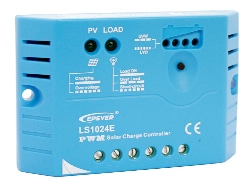
PWM types are relatively simple & use a switch between the solar panel and the battery. The switch is able to open and close rapidly, this makes it able to pulse or “throttle back” the electricity coming from a solar panel, which means thatas the batteries become full the charge current can be steadily reduced to a point where no charge will be sent.
Since PWM controllers operate with a switch only, the solar panel voltage during operation is roughly equal to the battery voltage. This means that you need to use nominal voltage solar panels with a PWM controller (36-cell panels for 12 V nominal, producing 16 to 20 volts as explained earlier)
Even with a nominal voltage panel, a PWM controller will operate below the maximum power voltage (Vmp). When it’s cold outside or when the battery voltage gets low, a PWM controller will operate well below Vmp and the max power (Pmp) rating of the solar panel.
To take full advantage of a solar panels maximum power output, you need an MPPT controller.
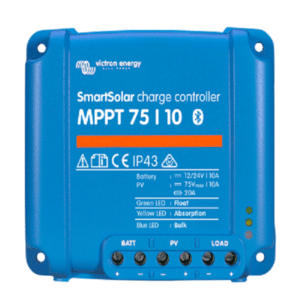
MPPT controllers are comparatively more sophisticated. They can track & adjust the input voltage and current from the solar panel to find the optimum operating voltage that will generate the most power at a given moment.
Below are graphs of the current vs. voltage and current vs.power for a nominal voltage solar panel. By continuously tracking and operating at the optimum operating voltage, a MPPT controller will be able to generate more power than a PWM controller.
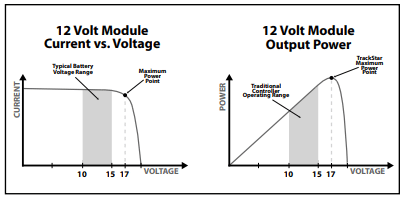
Which Type Should I Get ?
If there is not a long wire run, which in a motorhome or campervan, there isn’t and nominal voltage solar panels are being used, which they are, a PWM controller often the choice, as it will do the job & is cheaper.
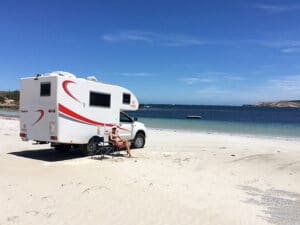
PWM controllers are fine in very sunny conditions, like Southern Spain, since some wasted solar electricity isn’t critical. Any advantage in using an MPPT controller may be minimal since the solar panel voltage is lower in warm conditions.
Another consideration is the size of the system. PWM controllers are often used in smaller, lower cost systems where the added cost with MPPT is not worth it.
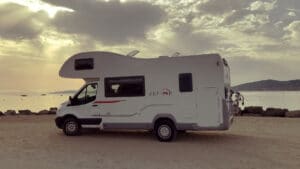
In places with variable sunshine, fluctuating temperatures and shading, in northern or southern latitudes where the sunis lower in the sky in winter, so is at an increased angle to the solar panel an MPPT is by far more desirable since it can maximize output in all conditions.
It is all down to getting the right tool for the job.
Quick Note;
If you already have a solar panel, but you are not getting as much charging power as you had hoped, look at your solar charge controller.
Instead of rushing out & replacing it with a larger capacity (& size) solar panel kit, it maybe as simple as getting a much more efficient charge controller that can utilise the full charging power potential from the solar panel that you already have.
So – It Really Depends On What You Are Going To Be Doing
For a properly-sized system, MPPT and PWM controllers will both do a great job of keeping the batteries charged.
Choosing between PWM or MPPT really depends on:
- your power usage.
- your main touring locations.
- your time spent EHU on site or wild camping.
- Do you use an Inverter
So lets look at two very different examples of ways that you might use a motorhome, to see which type of charge controller would be best.
If you use your motorhome mainly in the summer months & tour in the UK & Europe spending the bulk of your time on camp sites with EHU & only occasionally spend a few nights “wild camping” & really only want your solar charging kit to keep your batteries topped up when your motorhome is not being used, for example at a storage area where there is no electric. Then a small panel & a PWM solar charge controller would be ideal.
Wild Camping or On Site With EHU ?
If you use your motorhome all year round touring in the UK & Europe spending the bulk of your time “wild camping”, on sites with no EHU & in European Aires, running lights, pumps, fridge, blown air heating & an inverter for sat tv, laptop, hair dryer etc. You are going to want to get all of the charging capability from your solar system. An MPPT charger would be the obvious choice.
Most people will be somewhere in the middle of these two examples.
Personally I have a large motorhome with a 120w panel going to a Morning Star charge controller that feeds 2 x 90 Ah batteries, plus a 90Ah engine battery. I also have a 12v Bi-Cool system & a 1000w inverter. My motorhome a lot & it is a mixture of EHU & wild camping, aires etc.
I like to keep my batteries charged up for the nighttime usage without having to worry all the time. I don’t like the idea of sitting with only 1 light on & no sat tv because the battery voltage is down. I therefore use a MPPT charger to get the maximum from my solar panel set up.
So, what is a solar panel charge controller ? It truly is the brains behind your solar charging system. The solar panel, just chucks out a current & the batteries sit there & have to accept whatever is thrown at them. The charge controller makes the system work safely, efficiently & seamlessly to make sure you have the power that you need.
